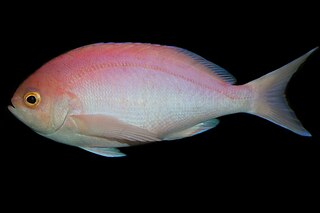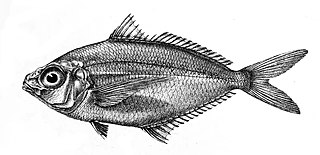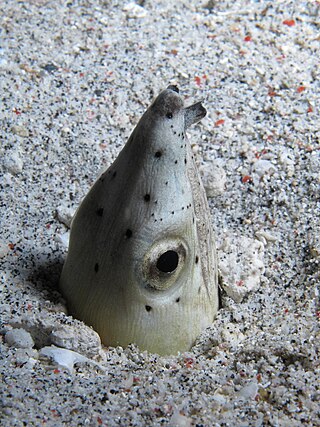
The oceanic whitetip shark is a large pelagic requiem shark inhabiting tropical and warm temperate seas. It has a stocky body with long, white-tipped, rounded fins. The species is typically solitary, though they may gather in large numbers at food concentrations. Bony fish and cephalopods are the main components of its diet and females give live birth.

Ophichthidae is a family of fish in the order Anguilliformes, commonly known as the snake eels. The term "Ophichthidae" comes from Greek ophis ("serpent") and ichthys ("fish"). Snake eels are also burrowing eels. They are named for their physical appearance, as they have long, cylindrical, snake-like bodies. This family is found worldwide in tropical to warm temperate waters. They inhabit a wide range of habitats, from coastal shallows and even rivers, to depths below 800 m (2,600 ft). Most species are bottom dwellers, hiding in mud or sand to capture their prey of crustaceans and small fish, but some are pelagic.

The New Zealand longfin eel, also known as ōrea, is a species of freshwater eel that is endemic to New Zealand. It is the largest freshwater eel in New Zealand and the only endemic species – the other eels found in New Zealand are the native shortfin eel, also found in Australia, and the naturally introduced Australian longfin eel. Longfin eels are long-lived, migrating to the Pacific Ocean near Tonga to breed at the end of their lives. They are good climbers as juveniles and so are found in streams and lakes a long way inland. An important traditional food source for Māori, who name them ōrea, longfin eel numbers are declining and they are classified as endangered, but over one hundred tonnes are still commercially fished each year.

The mottled eel, also known as the African mottled eel, the Indian longfin eel, the Indian mottled eel, the long-finned eel or the river eel, is a demersal, catadromous eel in the family Anguillidae. It was described by John McClelland in 1844. It is a tropical, freshwater eel which is known from East Africa, Bangladesh, Andaman Islands, Mozambique, Malawi, Sri Lanka, Sumatra, and Indonesia and recently from Madagascar. The eels spend most of their lives in freshwater at a depth range of 3–10 metres, but migrate to the Indian Ocean to breed. Males can reach a maximum total length of 121 centimetres and a maximum weight of 7,000 grams. The eels feed primarily off of benthic crustaceans, mollusks, finfish and worms.

The pink maomao, also known as the longfin perch, is a species of marine ray-finned fish, a member of the subfamily Anthiinae which is part of the grouper and sea bass family Serranidae. It is found in the southern Pacific and the southeastern Indian Ocean.
Lethrinops longimanus is a species of cichlid endemic to Lake Malawi where it is found in deep waters 50 to 70 metres over sandy substrates. This species grows to a length of 15.3 centimetres (6.0 in) SL.
Placidochromis longimanus is a species of cichlid native to the southern portion of Lake Malawi, Lake Malombe and the Shire River. It is believed to only be found in areas vegetated with Ceratophyllum and Najas at approximately 10 metres (33 ft) in depth. This species can reach a length of 14.5 centimetres (5.7 in) TL. It is also important to local commercial fisheries as well as being found in the aquarium trade. It is the type species of the genus Placidochromis.

Eels are ray-finned fish belonging to the order Anguilliformes, which consists of eight suborders, 20 families, 164 genera, and about 1000 species. Eels undergo considerable development from the early larval stage to the eventual adult stage and are usually predators.

Mastacembelus ellipsifer is a species of spiny eel that is endemic to Lake Tanganyika in Africa and sometimes kept in aquariums. Although sometimes called the Tanganyikan spiny eel, it is only one of fifteen spiny eel species in the Tanganyikan basin.

Eels are elongated fish, ranging in length from five centimetres (2 in) to four metres (13 ft). Adults range in weight from 30 grams to over 25 kilograms. They possess no pelvic fins, and many species also lack pectoral fins. The dorsal and anal fins are fused with the caudal or tail fin, forming a single ribbon running along much of the length of the animal. Most eels live in the shallow waters of the ocean and burrow into sand, mud, or amongst rocks. A majority of eel species are nocturnal and thus are rarely seen. Sometimes, they are seen living together in holes, or "eel pits". Some species of eels live in deeper water on the continental shelves and over the slopes deep as 4,000 metres (13,000 ft). Only members of the family Anguillidae regularly inhabit fresh water, but they too return to the sea to breed.
Ctenochirichthys is a monospecific genus of marine ray-finned fish belonging to the family Oneirodidae, the dreamers, a family of deep sea anglerfishes. The only species in the genus is Ctenochirichthys longimanus is known only from two locations, on in the Atlantic Ocean and the other in the Western Pacific Ocean.
The Blackedge conger is an eel in the family Congridae. It was described by David Starr Jordan and John Otterbein Snyder in 1901, originally under the genus Leptocephalus. It is a marine, deep water-dwelling eel which is known from Japan to the Philippines, in the western Pacific Ocean. It dwells at a depth range of 150–450 metres (490–1,480 ft). Males can reach a maximum total length of 54 centimetres.

Taylor's garden-eel is a heteroconger belonging to the family Congridae. It is native to the central Indo-Pacific.

The longfin mojarra is a species of mojarra native to the coastal waters of the Indian Ocean from India to the western Pacific. This species grows to 15 cm (5.9 in) in total length, though most do not exceed 10 cm (3.9 in). This species is of minor importance to local commercial fisheries, usually being made into fish meal or feed for ducks. It is the only known member of the genus Pentaprion.
Apterichtus equatorialis, the finless eel or equatorial eel, is a species of snake eel native to the eastern Pacific Ocean, from the Gulf of California to Panama and around the Galapagos Islands. This species can be found at depths of from 106 to 125 metres inhabiting areas with bottoms of sand or mud. This species can reach a length of 27 centimetres (11 in) TL.

The highfin snake eel (Ophichthus altipennis, also known as the blackfin snake eel or the black-finned snake eel, is an eel in the family Ophichthidae. It was described by Johann Jakob Kaup in 1856, originally under the genus Microdonophis. It is a marine, tropical eel known from the eastern Indian Ocean and northwestern and western central Pacific Ocean, including Australia, French Polynesia, Indonesia, Japan, the Marshall Islands, Malaysia, the Philippines, and Papua New Guinea. It dwells at a depth range of 0 to 40 m, and forms burrows in soft inshore sand sediments. Males can reach a maximum total length of 103 cm.

The rice-paddy eel is an eel in the family Ophichthidae. It was described by Francis Buchanan-Hamilton in 1822, originally in the genus Ophisurus. It is a tropical, marine eel which is known from the Indo-West Pacific, including Somalia, Tanzania, South Africa, India, Pakistan, Sri Lanka, Indonesia, Polynesia, Australia, Bangladesh, Cambodia, Kenya, Madagascar, the Philippines, Malaysia, Mozambique, Seychelles, Saudi Arabia, Taiwan, China, Thailand, Vietnam, and southern Yemen. It is an anadromous species and spawns in freshwater, often in rice paddies during the rainy season, earning it its common name. It also spends time in lagoons, estuaries and coastal rivers, in which it lives in burrows in the river bottom and bank. Males can reach a maximum total length (TL) of 100 centimetres, but more commonly reach a TL of 70 cm.
The Mekong flying barb is a species of cyprinid found in Mekong river basins in Thailand, Laos, Cambodia and Viet Nam.
The Crozet scad is a species of jack mackerel from the family Carangidae, the jacks, pompanos and trevallies, which is found off oceanic islands and over banks and sea mountains in the south east Atlantic and south western Indian Oceans.

Plectranthias longimanus, the longfin perchlet, is a species of fish in the family Serranidae occurring in the Indo-Pacific Ocean.













